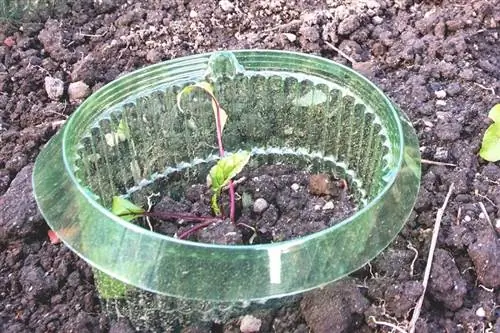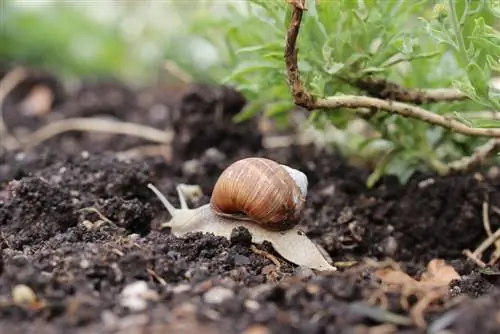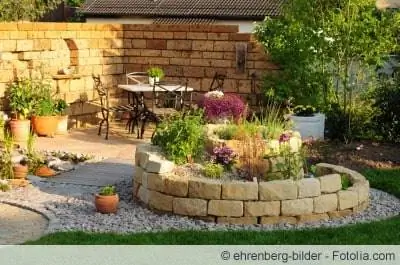- Author admin [email protected].
- Public 2023-12-17 03:39.
- Last modified 2025-06-01 06:48.
A snail fence can save you a lot of trouble in the garden. For many hobby gardeners, snail infestation is a horror. The snail fence is constructed very simply, so no extensive prior knowledge is required to build the fence. Nevertheless, this fence ensures that the snails can no longer get into the cultivated areas.
Plastic panels are required for the snail fence. Here, for example, you can use old records that have been lying around uselessly in the garage or basement for a long time.
What is needed for a snail fence?
- Mounting Clamps
- Plastic craft plates (also available in hardware stores)
- Jigsaw
- Superglue for plastic
Pattex superglue for plastic is particularly recommended for building the snail fence. Because this was developed specifically for working with plastic. It is also solvent-free, so it can also be used close to food without any problems. After a short drying time, the parts that were glued with the adhesive can then harden overnight.
Instructions - building a snail fence
Before you can start building, you must first measure the bed for which the fence is intended. If you assume a size of 200 x 200 cm, then the following parts are required: A total of four panels: One with a length of 200 cm and a height of 25 cm, four panels with a height of 200 cm x 10 cm, four 2 cm wide strips of plastic with a length of 200 cm.
- The first piece serves as an actual fence and therefore also to ward off the snails. This does not yet offer sufficient protection.
- If you want to build a safe snail fence, you also need climbing protection.
- Therefore, the second plastic plate is simply glued to the first at an angle of 45 degrees.
- Now everything should either be held firmly in place, or if there are mounting clamps, use them to support it.
Once the superglue has dried out, you can continue. Finally, the fence needs the small so-called nose. This ensures that the slugs lose their footing at this point and fall to the ground. So there is no chance of reaching the bed. Once everything has dried overnight, you can start installing the snail fence.
- To do this, you must first dig a gap about 10 cm deep around the selected bed.
- The four sides of the fence can then be inserted one after the other and aligned with each other.
- The four columns then have to be filled in to fix them.
- All corner points are then also glued with superglue so that no gaps remain.
Tip:
If necessary, the fence can also be provided with additional fastening materials, such as cord or wire, if the construction seems too unsafe.
Copper snail fence
Another very popular form is the copper snail fence. The structure is almost the same as the fence described above, except that a different material is used here. This doesn't look particularly pretty, but a very narrow strip is usually enough to keep the snails away from the bed.
How does a copper snail fence work?
You simply place the thin strip on the ground around the respective bed. It is then fixed so that it cannot fly away or be washed away by the rain. However, you should be aware that copper contains toxic substances that can even be dangerous to humans. Snails have the right intuition here and immediately sense that this stripe doesn't mean anything good, so they stay away straight away. The toxic substances contained in copper damage the snails' mucous membrane as it oxidizes with the copper. The copper strip should therefore be used carefully. In addition, this can be covered with leaves or something similar so that it is not visible to everyone.
The electric snail fence
Another variant is the electric snail fence. This can be used if you have really stubborn snails. It is also ideal if you combine several methods together. The electric snail fence is a plastic fence that has harmless and lightweight power lines. This also keeps the snails away from the bed. In addition, you should also remove snails by hand from time to time. To do this you simply have to lay out a few boards. The snails can then hide under these boards during the day, which is what they usually do. You can then pick them up and put them somewhere else.
Biological and chemical methods against snails
If the snail fence still doesn't have the desired effect, then you still have the choice between biological and chemical methods. The most popular remedies in this area are, for example, slug pellets. However, caution is advised here, as slug pellets are also poisonous to other animal species. Beloved pets can also suffer poisoning if they come into contact with slug pellets. Biological methods are better. You simply add other popular plants, for example between the lettuce and the like, that you also like. Then the snails can eat their fill of the other plants and the other crops are spared.
What you should know about snail fences in brief
If you want to protect your small vegetable plantation in your specially created vegetable garden, you have to come up with something against these little beasts. The simplest method is of course a small snail fence, because this represents a big problem for the slugs and also for other species of snails.
- The most important feature of a snail fence is an external surface that is so smooth that no snail has a chance of getting into the vegetable garden over this obstacle.
- Furthermore, such a small fence is of course also a nice decoration around the vegetable garden, so that you also get something out of it in addition to keeping the annoying slugs away.
To build this fence yourself, you should buy metal strips with a width of approx. 15 cm. There are special strips that are made specifically for this purpose and have an extremely smooth surface. You simply place these metal strips around the vegetable garden in the form of a fence and of course fasten it so that it cannot be knocked over by the wind or something similar.
You can also use wooden palisades, but these do not protect as well because - as already mentioned - the surface has to be so smooth that the slug basically cannot find a grip.
In terms of price, there are of course big differences, because the metal strips made especially for this purpose cost around four times as much as those made of wood, for example. However, this amount is certainly more pleasant than having to go without fresh vegetables again and again because slugs have, so to speak, destroyed the vegetable garden.






